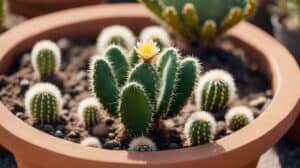Sky-High Beauty: Propagating Giant White Bird of Paradise (Strelitzia nicolai)

The Giant White Bird of Paradise (Strelitzia nicolai) is a stunning plant that can add a touch of tropical beauty to any garden or indoor space.
With its tall, slender stems and large, glossy leaves, it’s no wonder that this plant is becoming increasingly popular among gardeners and plant enthusiasts alike.
However, propagating this plant can be a bit of a challenge, which is why it’s important to understand the best methods for doing so.
One of the most important things to keep in mind when propagating Giant White Bird of Paradise is that it is a slow-growing plant.
This means that it can take some time for new shoots to appear, and even longer for the plant to reach maturity.
However, with patience and the right techniques, it is possible to successfully propagate this beautiful plant.
In this article, we will explore some of the best methods for propagating Giant White Bird of Paradise, including tips for caring for the plant as it grows.
Understanding the Giant White Bird of Paradise
Botanical Profile
The Giant White Bird of Paradise, also known as Strelitzia nicolai, is a flowering plant native to South Africa.
It belongs to the Strelitziaceae family, which also includes the more commonly known Bird of Paradise plant.
The Giant White Bird of Paradise is a herbaceous perennial that can grow up to 30 feet tall in its natural habitat, making it an impressive addition to any garden.
The plant boasts large, paddle-shaped leaves that can reach up to 8 feet in length and 2 feet in width.
The leaves are glossy and dark green in color, with a prominent midrib and parallel veins.
The plant also produces impressive white flowers that resemble the head of a bird, hence the common name.
Growth Habits and Characteristics
The Giant White Bird of Paradise is a relatively easy plant to care for, as it is drought-tolerant and can thrive in a variety of soil types.
It prefers full sun to partial shade and can grow in both tropical and subtropical climates. In colder climates, it can be grown as a houseplant.
The plant is a slow grower, taking up to 5 years to reach maturity. It is also a clumping plant, meaning it produces multiple stems from the base.
This can make it a great choice for creating a tropical-looking screen or hedge.
One thing to note is that the Giant White Bird of Paradise is not frost-tolerant, so it should be protected during colder months.
It is also important to avoid overwatering, as this can lead to root rot.
Overall, the Giant White Bird of Paradise is a stunning plant that can add a touch of the tropics to any garden or indoor space.
With proper care, it can thrive for years to come.
Cultivation Essentials
Optimal Growing Conditions
Giant White Bird of Paradise thrives in warm, humid environments with plenty of sunlight.
It prefers temperatures between 65°F and 80°F, and can tolerate temperatures as low as 50°F.
It needs at least six hours of direct sunlight each day for optimal growth.
It is important to note that the plant should not be exposed to temperatures below 40°F or above 100°F for extended periods of time.
Soil and Fertilization Needs
The plant prefers well-draining soil that is rich in organic matter. A soil mixture that is high in peat moss, perlite, and sand is ideal.
The plant should be fertilized every two weeks during the growing season with a balanced fertilizer.
It is important to avoid overfertilizing the plant, as this can cause damage to the roots.
Watering and Humidity Requirements
Giant White Bird of Paradise requires regular watering, but it is important not to overwater the plant. The soil should be kept moist but not soggy.
It is important to allow the soil to dry out slightly between waterings. The plant also benefits from high humidity levels.
Misting the leaves with water or placing a humidifier nearby can help to maintain the necessary humidity levels.
Overall, providing the right growing conditions, soil mixture, fertilization, and watering will result in a healthy and thriving Giant White Bird of Paradise plant.
Propagation Techniques
Seed Propagation Method
One of the easiest ways to propagate Giant White Bird of Paradise is through seeds.
The seeds are readily available and can be purchased from a reputable nursery.
The seeds should be sown in a well-draining soil mixture and kept moist until germination. Germination usually takes about 2-3 weeks.
Once the seedlings have developed a few leaves, they can be transplanted into individual pots.
The seedlings should be kept in a warm, bright location and watered regularly.
After a few months, the seedlings will be ready to be planted in their permanent location.
Division Method
Another way to propagate Giant White Bird of Paradise is through division. This method is best done in the spring when the plant is actively growing.
The plant should be carefully dug up, and the root ball should be gently separated into smaller sections.
Each section should have a good amount of roots and at least one healthy shoot.
The sections should be replanted in a well-draining soil mixture and watered regularly.
It’s important to keep the newly divided plants in a warm, bright location until they have established themselves.
Propagation through division can help to rejuvenate an older plant and create new plants to add to the landscape.
Common Challenges and Solutions

Pest Management
The Giant White Bird of Paradise is susceptible to pests such as spider mites, mealybugs, and scale insects.
These pests can cause damage to the leaves and flowers of the plant, leading to stunted growth and reduced overall health.
To prevent and manage pest infestations, it is important to regularly inspect the plant for signs of pests and take action as soon as possible.
One effective solution for pest management is to use natural insecticides, such as neem oil or insecticidal soap.
These products are safe for the plant and the environment, and can effectively control pest populations.
It is important to follow the instructions carefully when using any type of insecticide, and to avoid overuse as this can lead to resistance.
Disease Prevention
The Giant White Bird of Paradise is generally resistant to diseases, but can be susceptible to fungal infections if the soil is too moist or if the plant is overwatered.
To prevent fungal infections, it is important to ensure proper drainage and avoid overwatering.
If fungal infections do occur, they can be treated with fungicides.
Another common issue with the Giant White Bird of Paradise is root rot, which can occur if the plant is kept in soil that is too wet or if it is overwatered.
To prevent root rot, it is important to use well-draining soil and to allow the soil to dry out slightly between waterings.
If root rot does occur, it is important to remove the affected roots and repot the plant in fresh, well-draining soil.
Overall, the Giant White Bird of Paradise is a relatively low-maintenance plant that can thrive with proper care and attention.
By following these tips for pest management and disease prevention, growers can ensure that their plants remain healthy and beautiful for years to come.
Frequently Asked Questions

How can I propagate a White Bird of Paradise from cuttings?
Propagating a White Bird of Paradise from cuttings is not recommended as it is difficult and rarely successful.
The best way to propagate this plant is through division or by growing from seeds.
Is it possible to root a Bird of Paradise leaf in water?
No, it is not possible to root a Bird of Paradise leaf in water. The plant can only be propagated through division or by growing from seeds.
What are the steps to divide a White Bird of Paradise plant?
To divide a White Bird of Paradise plant, start by carefully removing it from its pot. Gently separate the roots and rhizomes using a sharp, clean knife.
Make sure each division has at least one healthy leaf and a good portion of the rhizome. Repot each division in a well-draining soil mix.
Can you grow a White Bird of Paradise from seeds, and how?
Yes, you can grow a White Bird of Paradise from seeds. Start by soaking the seeds in warm water for 24 hours to soften the hard outer shell.
Plant the seeds in a well-draining soil mix, keeping them moist but not waterlogged. Germination can take up to 6 weeks.
What should a healthy Bird of Paradise rhizome look like?
A healthy Bird of Paradise rhizome should be firm and fleshy, with no signs of rot or damage.
It should also have several healthy roots and at least one growing point.
Are there any special considerations when propagating a Mexican Bird of Paradise?
Mexican Bird of Paradise (Caesalpinia mexicana) can be propagated by seeds or cuttings.
Cuttings should be taken in spring or early summer and should be at least 6 inches long.
They should be planted in a well-draining soil mix and kept moist but not waterlogged.
Mexican Bird of Paradise also prefers full sun and well-draining soil.












